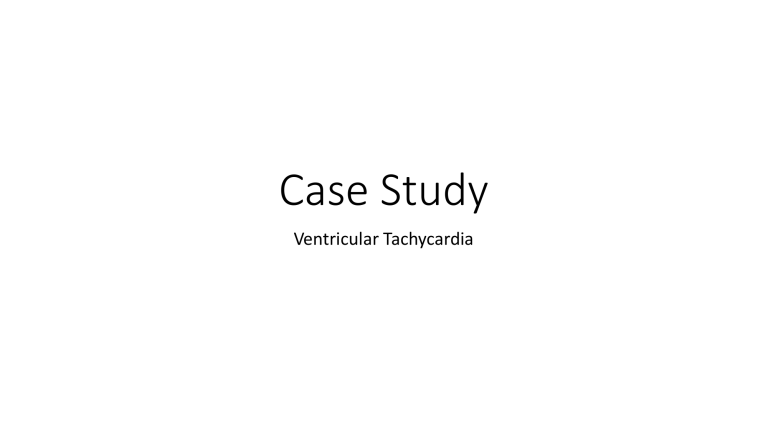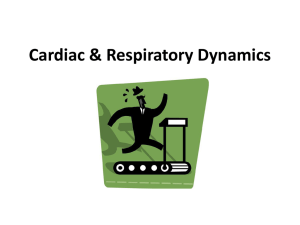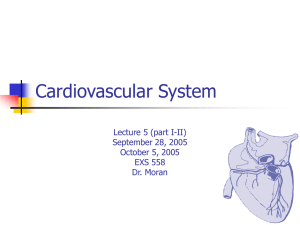
Case Study Ventricular Tachycardia Ms. Betty W. Johnson Case: Wald D, Heckman J, Cripe J, Basic Science- Clinical Correlation Exercise Using a High Fidelity Simulator: A case of Ventricular Tachycardia. MedEdPortal Case History: Ms. Johnson is a 73-year-old female who presents to the emergency department with a complaint of chest pain and dizziness after passing out. These complaints started about 30 minutes before arrival while she was waiting in line at the bank. She recalls feeling warm and flushed and was noted by a bystander at the bank to have a brief fainting episode. Upon arrival at the hospital, the patient is awake, answering questions, but complains of feeling weak, chest heaviness and shortness of breath. Vital signs – HR 184 bpm, RR 26, BP 82/40 mmHg, SaO2 92% (increase to 97% with supplemental oxygen) General Appearance She is awake, alert and able to answer your questions. Lungs – Rales (crackles) Abdomen – Soft, non-tender Extremities – no edema Skin – Cool and clammy Discuss the following questions: What is the definition of tachycardia? What are the determinants of cardiac output? What is the definition of stroke volume? What is the definition of tachycardia? HR >100 bpm What are the determinants of cardiac output? The determinants of CO are HR and SV, (CO = HR x SV). The CO represents the amount of blood that is pumped by the heart (ventricles) in one minute. What is the definition of stroke volume? SV represents the volume of blood that is pumped from the heart with each heart beat (from the ventricles). This is calculated by subtracting endsystolic volume (ESV~50 ml) from the end-diastolic volume (EDV~120 ml) (SV = EDV – ESV). In a typical 70 kg adult the SV is ~70 ml of blood. In a patient with a HR of 70 bpm, the CO approximates 4.9 liters/minute. • What factors affect stroke volume? • A number of factors can affect the SV including • • • • • heart size aerobic conditioning cardiac contractility preload (EDV) afterload Discuss the answers to the following: How will this patient’s heart rate affect her stroke volume? What effect does this patient’s heart rate have on her cardiac output? How will this patient’s heart rate affect her stroke volume? Because the ventricular rate is very fast, the SV will decrease. This occurs because of the decrease in the diastolic filling time that can occur with marked tachycardia. This leads to a decrease in the EDV. Remember, during the cardiac cycle, the heart is in systole for approximately 1/3 of the time and diastole for 2/3 of the time. The heart fills during diastole. What effect does this patient’s heart rate have on her cardiac output? The CO is reduced due to the very fast ventricular rate and lack of a properly timed or coordinated atrial and ventricular contraction. Hemodynamic compromise is more likely when underlying left ventricular dysfunction is present or with very fast ventricular rates. A significant decrease in CO may lead to a cascade of complications including; diminished myocardial perfusion, worsening inotropic response (decreased cardiac contractility), and subsequent pulmonary edema. The rapid HR can not compensate for the marked decrease in SV. Overview of Volume Changes Copyright © The McGraw-Hill Companies, Inc. Permission required for reproduction or display. 1 Right ventricular output exceeds left ventricular output. 2 Pressure backs up. 3 Fluid accumulates in pulmonary tissue. 1 2 3 (a) Pulmonary edema 19-11 Figure 19.21a • If the left ventricle pumps less blood than the right, the blood pressure backs up into the lungs and causes pulmonary edema Q: Why did this patient pass out? 1/19/15 The patient developed VT which resulted in a marked increase in ventricular rate which lead to a decrease in CO (CO = HR X stroke volume - SV) which in turn lead to a precipitous drop in MAP (MAP = CO X systemic vascular resistance - SVR). The above series of events resulted in a decrease in cerebral perfusion. She fainted because of orthostatic hypotension. This is a relatively common scenario and is encountered in some patients, particularly the elderly or those dehydrated. When a patient stands, there is a redistribution of approximately 750 mL of blood volume into the lower extremity venous circulation (capacitance vessels). The baroceceptor reflex, in an otherwise normal patient, helps to compensate for the decreased MAP associated with this redistribution of blood volume by increasing the SVR. 1/19/15 The mean arterial pressure is defined as the average pressure in the arteries during the cardiac cycle. MAP = [(2 x diastolic pressure) + systolic pressure] / 3, or MAP = Diastolic pressure + 1/3 pulse pressure. What are the determinants of the mean arterial blood pressure? 1/19/15 The determinants of MAP are CO and SVR, (MAP = CO X SVR). At the bedside, it is difficult to monitor CO and SVR, as these values are typically unable to be measured in real time. These values however can be obtained with the use of a pulmonary artery catheter. 1/19/15 Discuss: How do each of the four factors increase SVR 1) an increase in sympathetic nerve activity to selected systemic arterioles (e.g. enteric, cutaneous) 2) increased release of norepinephrine 3) increased tone of the vascular smooth muscle in the arterioles 4) the reduction in the radii (r). 1/19/15






